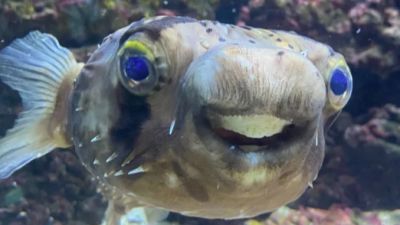Kent pet pufferfish named Goldie gets life-saving surgery to fix 'teeth' so big she can't eat

Watch as five-year-old Goldie has a dental procedure to enable her to eat properly
A pet pufferfish whose 'teeth' had grown so large she could barely eat has undergone life-saving surgery to prevent her from starving to death.
Goldie, a five-year-old porcupine pufferfish, was rushed to the dentist by her owner after he realised she wasn't able to eat properly because of her overgrown beak.
Pufferfish have teeth that grow continuously and need to be worn down by food items found in their wild diet.
But unfortunately Goldie wasn't eating the right foods to perfect her beak.
Expert vets at the Sandhole Veterinary Centre, Kent, were able to perform a dental procedure where Goldie's overgrown beak was trimmed so she could start eating again.
Goldie's owner, Mark Byatt, 64, who lives in Leybourne, Kent, said: “About three months ago, we noticed her front beak was growing very quickly even though she was eating cockle in shell every day.
“We aren’t sure why Goldie’s teeth never really managed to grind themselves naturally but we knew we needed to get them filed, although we were unsure about how to achieve this.
“I was also very concerned about the process of getting Goldie to the surgery, as transporting large tropical fish is not without risk.
“However, after discussing my concerns with Debbie at Sandhole, we came up with a plan to transport her there quickly and safely.”
Mark then had an anxious wait while specialist Daniel Calvo Carrasco successfully trimmed Goldie’s overgrown beak.
Daniel described how Goldie’s problem had arisen: “Porcupine pufferfish teeth are known as beaks and grow continuously throughout their lives.
“They’re usually kept short naturally, as they’re worn down on their regular diet of hard-shelled foods but, while these foods are provided in her home environment, she is not as forthcoming in eating them as her other tank mates.
“As a result, her upper beak grew to the point where it was hindering her ability to eat effectively.
“Goldie was brought into the practice in a large watertight container containingwater from her home tank and a licensed fish anaesthetic was placed into the water until she achieved a light plane of anaesthesia.
“To support her further, the water was oxygenated throughout.
"This meant she was still breathing nicely throughout but was able to be held for brief periods out of the water without becoming too stressed.”
Porcupine pufferfish have the ability to inflate their bodies, with the increase in size (almost double vertically) reducing the range of potential predators to those with much bigger mouths.
A second defence mechanism is provided by sharp spines which radiate outwards.
When the fish is inflated and Daniel said these both had to be taken into consideration throughout Goldie’s procedure.
Daniel added: “Debbie was able to hold Goldie in a damp towel to prevent her becoming too dry, while also ensuring she was protected if she did trigger her defence mechanism to inflate her body and activate her spines.
“It was during those brief periods out of the anaesthetic water that I was able to use a dental burr to cut through her upper beak and reduce its length by half.
"Once the procedure had been completed, Goldie was placed into a second large container with water from her home tank to recover from the anaesthetic.
“She responded well. Within five minutes, she was able to stay up right in the water and within 10 minutes she was back to happily swimming around.
“The whole procedure went swimmingly and was conducted in under an hour without any stress at all and Goldie was back home and eating well within two hours.”